1972
South Vietnamese fight to open road to An Loc
^top^
Units of South Vietnam's 9th and 21st Divisions, along with several
South Vietnamese airborne battalions, open new stretches of road south
of An Loc and come within three kilometers of the besieged city. In
the Central Highlands, North Vietnamese troops, preceded by heavy
shelling, tried to break through the lines of South Vietnam's 23rd
Division defending Kontum, but the South Vietnamese troops held firm.
These actions were part of the North Vietnamese Nguyen Hue Offensive
(later called the "Easter Offensive"), a massive invasion by North
Vietnamese forces on March 30 to strike the blow that would win them
the war. The attacking force included 14 infantry divisions and 26
separate regiments, with more than 120'000 troops and approximately
1200 tanks and other armored vehicles. The main North Vietnamese objectives,
in addition to Quang Tri in the north and Kontum in the Central Highlands,
included An Loc farther to the south.
Initially, the South Vietnamese defenders were almost overwhelmed,
particularly in the northernmost provinces, where they abandoned their
positions in Quang Tri and fled south in the face of the enemy onslaught.
At Kontum and An Loc, the South Vietnamese were more successful in
defending against the attacks, but only after weeks of bitter fighting.
Although the defenders suffered heavy casualties, they managed to
hold their own with the aid of US advisors and American airpower.
Fighting continued all over South Vietnam into the summer months,
but eventually the South Vietnamese forces prevailed against the invaders
and retook Quang Tri in September. With the Communist invasion blunted,
President Nixon declared (prematurely) that the South Vietnamese victory
proved the viability of his Vietnamization program, which he had instituted
in 1969 to increase the combat capability of the South Vietnamese
armed forces. |
1971 USSR launches Mars 2, first spacecraft to crash land
on Mars
1967
Soviets ratify treaty banning nuclear weapons in space
^top^
One of the first major treaties designed to limit the spread of nuclear
weapons goes into effect as the USSR ratifies treaty with UK and US
banning nuclear weapons from outer space. The United States, Great
Britain, and several dozen other nations had already signed and/or
ratified the treaty. With the advent of the so-called "space race"
between the United States and the Soviet Union, which had begun in
1957 when the Russians successfully launched the Sputnik satellite,
some began to fear that outer space might be the next frontier for
the expansion of nuclear weapons. To forestall that eventuality, an
effort directed by the United Nations came to fruition in January
1967 when the United States, Great Britain, the Soviet Union, and
dozens of other nations signed off on a treaty banning nuclear weapons
from outer space. The agreement also banned nations from using the
moon, other planets, or any other "celestial bodies" as military outposts
or bases. The agreement was yet another step toward limiting nuclear
weapons. In 1959, dozens of nations, including the United States and
the Soviet Union, had agreed to ban nuclear weapons from Antarctica.
In July 1963, the Limited Test Ban Treaty was signed, banning open-air
and underwater nuclear tests. With the action taken in May 1967, outer
space was also officially declared off-limits for nuclear weapons.
|
1964
Bugging of US embassy in Moscow announced
^top^
In Washington, the US State Department announced that the US embassy
in Moscow had been bugged, citing evidence of a network of forty microphones
that had been found embedded in the embassy’s walls.
However, unbeknownst to US civilians outraged by revelations of the
undiplomatic Cold War-era espionage, US officials were aware of a
far more sinister anti-embassy program underway in Moscow at the time.
Beginning sometime in the 1950s, Soviet authorities began aiming microwave
radiation against the embassy, initially, it was suspected, as part
of a program to cause disoriented behavior, nerve disorders, or even
heart attacks among the embassy personnel. In the early 1960s, US
intelligence became aware of the Soviet’s use of offensive radiation
and
US President John F. Kennedy
responded by authorizing "Operation Pandora," a top secret research
program into the anti-personnel possibilities of non-ionizing microwave
radiation. Because of supposed national security issues, US workers
at the Moscow embassy were not informed of their continuous exposure
to the dangerous radiation until 1976, when suspicions of the KGB’s
use of the invisible weapon was publicly confirmed by US intelligence
officials. By that time at least two
US ambassadors had been likely killed as a direct result of the radiation
attacks, which probably caused an increase of cancer among the embassy
personnel, reproductive problems that may have resulted in birth defects,
and possibly even psychological disorders. Although Soviet officials
initially denied the attacks, they later contended that the emissions
had been employed in an attempt to incapacitate American surveillance
devices, not as an anti-personnel weapon. |
1964
US begins air reconnaissance over Laos.
^top^
The United States initiates low-altitude target reconnaissance flights
over southern Laos by US Navy and Air Force aircraft. Two days later,
similar flights were commenced over northern Laos. These flights were
code-named Yankee Team and were meant to assist the Royal Lao forces
in their fight against the communist Pathet Lao and their North Vietnamese
and Viet Cong allies. |
1958 The United States and Canada established
the North American Air Defense Command.
1944
The Gustav Line collapses ^top^
During World War II, Allied
forces broke through the so-called Gustav Line at Monte Cassino, Italy,
effectively ending the German defense of Rome.
On 08 September 1943, the unconditional surrender of Italy had
been announced days after British Field Marshall Bernard Montgomery
landed his Eighth Army unopposed on the Italian peninsula.
However, the Germans were not about to allow the Allies this toehold
on the continent, and resistance stiffened, culminating in the fortification
of the so-called Volturno Line across the peninsula just north of
Naples. For the next three months, the Allied force, made up of primarily
British and American armies, but also New Zealander, Canadian, French-Moroccan,
and Italian Resistance units, pounded away at the Volturno Line, eventually
forcing the Germans north to the Gustav Line, which straddled the
peninsula about 120 km south of Rome.
On 22 January, an Allied force landed at Anzio north of the German
fortified line, but they failed to gain much more than a beachhead,
and suffered through intense German air and artillery attacks for
the next four months.
Beginning
on 11 May, the Allies launched a major offensive along the Gustav
Line, and on 18 May, Monte Cassino, a highly strategic town,
fell to the Allies. The next day, the Allies stormed across the Gustav
Line, and, on 23 May, Allied forces at Anzio joined in the offensive
and began to break out. On 01 June, the Germans began a mass
withdrawal to a line north of Rome, and on 04 June, the first
units of US troops entered the former Fascist capital. The next day,
Allied forces pushed through Rome in pursuit of the Germans. |
1943
Churchill and FDR plan D-Day
^top^
British
Prime Minister Winston Churchill and US President Franklin Roosevelt
set a date for the cross-Channel landing that would become D-Day-May
1, 1944. That date will prove a bit premature, as bad weather becomes
a factor. Addressing a joint session of Congress, Churchill warned
that the real danger at present was the "dragging-out of the war at
enormous expense" because of the risk that the Allies would become
"tired or bored or split" — and play into the hands of Germany
and Japan. He pushed for an early and massive attack on the "underbelly
of the Axis." And so, to "speed" things up, the British prime minister
and President Roosevelt set a date for a cross-Channel invasion of
Normandy, in northern France, for May 1, 1944, regardless of the problems
presented by the invasion of Italy, which was underway. It would be
carried out by 29 divisions, including a Free French division, if
possible. |
1940 A Moncornet et
Crépy-sur-Serre, le colonel de Gaulle et la 4ème DC arrêtent depuis le 17
la progression allemande; ils tiendront encore un jour — Weygand est
nommé général en chef à la place de Gamelin.
| 1935
A Swiss court declares the Protocols
of the Learned Elders of Zion to be forgeries,
plagiarisms, and obscene literature.
^top^
Regretfully, Mr. Henry Ford Snr.
initiated a campaign of Jew-hate in 1920. His Book, "THE INTERNATIONAL
JEW" WAS BASED MAINLY ON "THE PROTOCOLS'. However
Mr. Ford completely retracted his views expressed in his book:
"To my great regret I learn that
in the Dearborn Independent and in reprint pamphlets entitled, 'THE
INTERNATIONAL JEW', there have appeared articles which
induce the Jews to regard me as their enemy, promoting anti-Semitism.
"As a result of this survey I
am deeply mortified that this journal, which is intended to be constructive
and not destructive, has been made the medium for resurrecting exploded
fictions, for giving currency to the so-called Protocols of the
Wise Men of Zion, which have been demonstrated, as I learn,
to be gross forgeries, and for contending that the Jews have been
engaged in a conspiracy to control the capital and the industries
of the world, besides laying at their door many offenses against
decency, public order and good morals...I deem it to be my duty
as an honorable man to make amends for the wrong done to the Jews
as fellow men and brothers, by asking their forgiveness for the
harm which I have unintentionally committed, by retracting, as far
as lies within my power the offensive charges laid at their door
by these publications, and by giving them the unqualified assurance
that henceforth they may look to me for friendship and good will...
"Had I appreciated even the general
nature to say nothing of the details of these utterances, I would
have forbidden their circulation without a moment's hesitation...This
statement is made on my own initiative and wholly in the interest
of right and justice, and is in accordance with what I regard as
my solemn duty as a man and as a citizen."
What are the Protocols?
The following is a
brief summary of the evil ingredients of this
infamous forgery. The "Protocols" are set forth as the minutes of
twenty-four secret sessions of "the innermost circle of the rulers
of Zion". These fictitious minutes are thus laid down as twenty-four
"Protocols" or master plan to enslave the world by the most dastardly
and unscrupulous methods imaginable. Here are a few examples:
"Our right lies in force. The word "right" is an abstract
thought and proved by nothing. The word means no more than: Give
me what I want in order that thereby I may have a proof that I am
stronger than you." - Protocol 1. Article 12.
"The administrators, whom we shall choose from among the public,
with strict regard to their capacities for servile obedience, will
not be persons trained in the arts of government, and will therefore
easily become pawns in our game in the hands of men of learning
and genius who will be their advisors, specially bred and reared
from early childhood to rule the affairs of the whole world."-
Protocol 2. Article 2.
"In order to put public opinion into our hands we must bring
it into a state of bewilderment by giving expression from all sides
to so many contradictory opinions and for such length of time as
will suffice to make the gym (Gentiles) lose their heads in the
labyrinth and come to see that the best thing is to have no opinion
of any kind in matters political, which is not given to the public
to understand, because they are understood only by him who guides
the public. This is the first secret."- Protocol 5. Article 10.
"The Press, which with a few exceptions that may be disregarded,
is already entirely in our hands."- Protocol 7. Article 5.
How Did the Protocols Originate?
In 1901 a Russian official in the
Chancery of the Synod of Moscow named Serge A. Niles published
a strange work entitled, "The Great in the Little and the AntiChrist
as a Proximate Political Possibility". Nilus expressed the view
that only the Holy Russian Empire could save the world from the
rule of Antichrist. The idea behind the book was to bolster the
absolute authority of the Czarist regime. In 1905 a second edition
of the book appeared with one significant addition - the Protocols!
Thus was born one of the most infamous documents ever published.
And only Nilus himself ever claimed to have seen the original.
The "Protocols" Exposed as an Infamous Forgery
In August 1921 Mr. Phillip Graves,
correspondent of the London "Times" in Constantinople came into
the possession of a small book in a tattered condition. Such an
insignificant incident may well have passed unnoticed and been
swallowed into oblivion had not Mr. Graves recognized a sentence
as being identical with one of the "Protocols". Yet, THIS BOOK
HAD THE NAME "JOLI" AS THE AUTHOR!
Mr. Graves compared the book written
by Monsieur Joli with a copy of the "Protocols" and in it he found
repeated word for word, paragraph for paragraph and page for page
the text of the earlier book written by Joli. The only alteration
was that instead of the word "Zion" Joli had written "France",
and instead of "We the Jews" the original book had "The Emperor"!
The book written by Joli was a
satire directed against Napoleon III and was entitled "Dialogue
in Hell between Machiavelli and Montesquieu". IT HAD NOTHING WHATEVER
TO DO WITH THE JEWS!
In three consecutive issues dated
16th, 17th and 18th August, 1921 the London Times printed
long extracts from the "Protocols" side by side with Joli's "Dialogue
in Hell". Thus was the infamous forgery exposed as ONE OF THE
MOST INSOLENT FORGERIES OF ALL TIME.
Count Heinrich Coudenhove-Kalergi
in his book "ANTI-SEMITISM THROUGHOUT THE AGES" (English translation,
Hutchinson, 1935) writes: "This plagiarism is an anti-Semitic
forgery from the beginning to the end without any connection whatever
with Jewish personalities, groups, organizations or conferences.
The publication is in no wise, whether directly or indirectly,
a product of the Jewish spirit, or Jewish tradition, or of Jewish
sentiments and opinions.
"In the entire fraud committed
against humanity which the "Protocols" represents, the Jews are
merely innocent objects, while the anti-Semites were the guilty
agents. Thousands of Jews have been massacred, maltreated, plundered
and imprisoned in the Ukraine and in Germany on account of this
forgery. At the same time many millions of non-Jews have been
deceived by the "Protocols", they have been induced to commit
deeds and to utter words which they would most deeply regret were
the facts of the forgery known to them. No book and no event in
the history of modern anti-Semitism has played such an important
part as this plagiarism; it constitutes the piece de resistance,
the choice morsel of after-war anti-Semitism.
"It is, therefore, they duty
of all decent men in the world, be they non-Jews or Jews, Anti-Semites
or Philo-Semites, to work with all their might and see to it that
this shameless lie, forgery and calumny disappears from the world.
"It ought to be made clear
to all those who know the "Protocols" that the publication is
a plagiarism of fatal world importance. The work of enlightenment
is not only a duty to the calumniated Jews, but also to truth,
for it is no exaggeration to say that the so called "Protocols
of the Elders of Zion" are both one of the most insolent forgeries
of all time and one of the meanest calumnies which has existed
in human history."
Hitler knew only too well how to
manipulate the masses with lies of great magnitude and he exploited
the "Protocols" to the fullest extent. Four years after the publication
of the warning contained in Count Kalergi's book the harvest of
hatred against the Jews began in Europe, and the flames of the
holocaust were not extinguished until six million innocent Jewish
victims had perished.
The Law Steps In
Dr. A. Zander, editor of a Swiss
Nazi organ, published a series of articles on the acceptability
of the "Protocols". But Swiss law offered redress and community
leaders in that country determined to expose the fraudulent basis
of the iniquitous document before a well-respected court of justice.
Trial began in Berne on October
29, 1934, the plaintiffs being Dr. J. Dreyfus-Brodsky, Dr. Marcus
Cohen, and Dr. Marcus Ehrenpreis.
On May 19, 1935, the Cantonal
Court of Berne, after full investigation declared the "Protocols"
to be forgeries, plagiarisms, and obscene literature
and gave judgment in favor of the Cantonal Bernese Act. The Nazi,
Dr. Zander, was fined.
At Grahamstown, South Africa, in
August, 1934, the Court imposed fines totaling 1775 pounds ($4,500)
on three men for concocting a modern version of the "Protocols".
|
1928 51 frogs enter first annual "Frog Jumping Jubilee"
(Angel's Camp, California)
1921 US Congress
passed the Emergency Quota Act, which established national quotas for immigrants
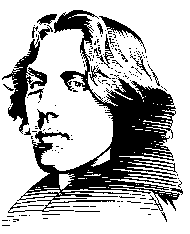 1897
Oscar Wilde is released from prison.
^top^ 1897
Oscar Wilde is released from prison.
^top^
after two years of hard labor. His experiences in prison were the
basis for his last work, The
Ballad of Reading Gaol (1898).
Wilde was born and educated in Ireland. He studied at Oxford, graduated
with honors in 1878, and remained in London. He became a popular society
figure valued at dinner parties for his witty remarks. Embracing the
late 19th century aesthetic movement, which embraced art for art's
sake, Wilde adopted the flamboyant style of a passionate poet and
self-published a volume of verse in 1881. He spent the following year
in the United States lecturing on poetry and art.
Wilde's dapper wardrobe and excessive devotion to art were parodied
in Gilbert and Sullivan's operetta Patience in 1882. After
returning to Britain, Wilde married and had two children. In 1888,
he published a collection of fairy tales he wrote for his children.
Meanwhile, he wrote reviews and became editor of Women's World.
In 1891, his only novel, The
Picture of Dorian Gray, was published. He wrote his first
play, The Duchess of Padua, the same year and wrote five
more before his arrest. His most successful comedies, including The
Importance of Being Earnest and Lady Windermere's Fan,
are still performed today.
In
1891, the Marquess of Queensbury denounced Wilde as a homosexual.
Wilde, who was involved with the marquess' son, sued the Marquess
for libel but lost the case when evidence supported the marquess'
allegations. Because homosexuality was still considered a crime in
England, Wilde
was arrested. Although his first trial resulted in a hung jury,
a second jury sentenced him to two years of hard labor. After his
release, Wilde fled to Paris and began writing again. He died of acute
meningitis just three years after his release.
SHORT FICTION by Oscar Wilde:
Lord
Arthur Savile's Crime / The
Sphinx without a Secret / The
Canterville Ghost / The
Model Millionaire / The
Happy Prince / The
Nightingale and the Rose / The
Selfish Giant / The
Devoted Friend / The
Remarkable Rocket / The
Portrait of Mr. W. H. / The
Young King / The
Birthday of the Infanta / The
Fisherman and his Soul / The
Star-Child
PROSE POEMS by Oscar Wilde
The
Artist / The
Doer of Good / The
Disciples / The
Master / The
House of Judgement / The
Teacher of Wisdom |
1885 The complete Old and New Testament English Revised
Version (EV or ERV) of the Bible was first published in England. After a
promised 20-year wait, US scholars on the ERV committee published an "Americanized"
edition in 1905, known afterward as the American Standard Version (ASV)
of the Bible.
1865 Confederate President Jefferson
Davis is captured by Union Cavalry in Georgia
1864
Battle of Spotsylvania concludes
^top^
A dozen
days of fighting around Spotsylvania ends with a Confederate attack
against the Union forces. The epic campaign between the Army of the
Potomac, under the effective direction of Ulysses S. Grant, and Robert
E. Lee's Army of Northern Virginia began at the beginning of May when
Union forces crossed the Rapidan River. After a bloody two-day battle
in the Wilderness forest, Grant moved his army further south toward
Spotsylvania Court House. This move was a departure from the tactics
of the previous three years in the eastern theater of the Civil War.
Since 1861, the Army of the Potomac had been coming down to Virginia
under different commanders only to be defeated by the Army of Northern
Virginia, usually under Lee's direction, and had always returned northward.
But Grant was different than the other Union generals. He knew that
by this time Lee could not sustain constant combat. The numerical
superiority of the Yankees would eventually wear Lee down. When Grant
ordered his troops to move south, a surge of enthusiasm swept the
Union veterans; they knew that in Grant they had an aggressive leader
who would not allow the Confederates time to breathe. Nevertheless,
the next stop proved to be more costly than the first. After the battle
in the Wilderness, Grant and Lee waged a footrace for the strategic
crossroads at Spotsylvania. Lee won the race, and his men dug in.
On May 8, Grant attacked Lee, initiating a battle that raged for 12
awful days. The climax came on May 12, when the two armies struggled
for nearly 20 hours over an area that became known as the Bloody Angle.
The fighting continued sporadically for the next week as the Yankees
tried to eject the Rebels from their breastworks. Finally, when the
Confederates attacked on May 19, Grant prepared to pull out of Spotsylvania.
Convinced he could never dislodge the Confederates from their positions,
he elected to try to circumvent Lee's army to the south. The Army
of the Potomac moved, leaving behind 18,000 casualties at Spotsylvania
to the Confederates' 12,000. In less than three weeks Grant had lost
33,000 men, with some of the worst fighting yet to come. 1864 Author
Nathaniel Hawthorne dies in New Hampshire |
1864 Last engagement in series of battles known as Spotsylvania
1862 Homestead Act becomes law provides cheap land
for settlement of US West
1856 Senator Charles Sumner,
of Massachusetts, speaks out against slavery
1836
Cynthia
Ann Parker, 11 (or 9?), is captured by Comanches.
^top^
She grows up among the Comanches, marries a Comanche, has children,
and then, at age 33 or so, is recaptured by whites, kept away forcibly
from her Comanche family, and after ten years or so of captivity,
starves herself to death. Her only surviving child was Quanah
Parker.
During a raid, Commanche,
Kiowa, and Caddo Indians in Texas kidnap nine-year-old Cynthia Ann
Parker and kill her family. Adopted into the Commanche tribe, she
lived a happy life until Texas Rangers recaptured her and forced her
to return to live again among Anglo-Americans. Silas and Lucy Parker
moved their young family from Illinois to Texas in 1832. To protect
themselves against the hostile Indians in the region, they erected
a solidly constructed civilian stockade about 40 miles east of present-day
Waco that came to be called Parker's Fort. The tall wooden stockade
was reportedly capable of holding off "a large enemy force" if properly
defended. However, when no Indian attacks materialized for many months,
the Parker family and the relatives who joined them in the fort became
careless. Frequently they left the bulletproof gates to the fort wide
open for long periods. On this day in 1836, several hundred Commanche,
Kiowa, and Caddo Indians staged a surprise attack. During the ensuing
battle, the Indians killed five of the Parkers. In the chaos, the
Indians abducted nine-year-old Cynthia Ann Parker and four other white
women and children. The Commanche and Caddo bands later divided women
and children between them. The Commanche took Parker, and she lived
with them for the next 25 years. Like many Plains Indian tribes, the
Commanche had long engaged in the practice of kidnapping their enemy's
women and children. Sometimes these captives were treated like slaves
who provided useful work and could be traded for valuable goods. Often,
though, captives eventually became full-fledged members of the tribe,
particularly if they were kidnapped as young children. Such was the
case with Parker. Anglo-Texans first learned that the young girl might
still be alive four years later. A trader named Williams reported
seeing Parker with a band of Commanche near the Canadian River in
northern Texas. He tried to purchase her release but failed. The Commanche
Chief Pahauka allowed Williams to speak to the girl, but she stared
at the ground and refused to answer his questions. After four years,
Parker apparently had become accustomed to Commanche ways and did
not want to leave. In 1845, two other white men saw Parker, who was
by then 17 years old. A Commanche warrior told them he was now her
husband, and the men reported "she is unwilling to leave" and "she
would run off and hide herself to avoid those who went to ransom her."
Clearly, Parker had come to think of herself as Commanche. By all
accounts, her husband, a rising young warrior named Peta Nocona, treated
her well, and the couple was happily married. She gave birth to three
children, two boys and a girl, and Nocona was reportedly so pleased
with her that he rejected the common practice of taking several wives
and remained monogamous. Unfortunately, Nocona was also a warrior
engaged in brutal war with the Anglo-American invaders, and he soon
attracted the wrath of the Texas Rangers for leading several successful
attacks on whites. In December 1860, a Ranger force attacked Nocona's
village. The Rangers mortally wounded Nocona and captured Parker and
her daughter, Prairie Flower. Returned to Anglo society against her
will, Parker was taken to her uncle's farm in Birdville, Texas, where
she tried to run away several times. However, with her husband dead
and her adopted people fighting a losing battle to survive, Parker
apparently resigned herself to an unhappy life among a people she
no longer understood. Prairie Flower, her one connection to her old
life, died of influenza and pneumonia in 1863. Depressed and lonely,
Parker struggled on for seven more years. Weakened by self-imposed
starvation, she died of influenza in 1870. |
1822 General Agustín de Iturbide crowns himself
Agustín I, 1st emperor of Mexico. His reign would last exactly 10
months.
1781 Jacques Necker [30 Sep 1732 – 09
Apr 1804] resigns his office (which he held since 29 Jun 1777) of director
general of finance of Louis XVI of France, because of the opposition of
the leading minister, Jean-Frédéric Phelypeaux comte de Maurepas,
and the hostility of queen Marie-Antoinette. Earlier in the year Necker
had published his Compte Rendu au Roi claiming a surplus of 10
million livres in the hope of concealing an actual deficit of 46 million
livres, due to the attempt to finance French participation in the US War
of Independence without raising taxes.
1780 About
midday, near-total darkness descends on much of New England to this day
it's cause is still unexplained
1749
Ohio Company chartered ^top^
King George II of England granted
the Ohio Company a charter of several hundred thousand acres of land
around the forks of the Ohio River, formalizing efforts by the colony
of Virginia to expand its settlements westward. France had claimed
the entire Ohio River Valley in the previous century, although English
fur traders and settlers soon contested these claims. The royal chartering
of the Ohio Company, an organization founded primarily by Virginian
planters in 1747, directly challenged the French claims and became
a direct cause of the outbreak of the last and most important of the
French and Indian Wars in 1754. With the defeat of the French in 1763,
the Ohio River and the Great Lakes areas were placed within the boundaries
of Canada, and the Ohio Company was merged with another land company
to better exploit the region. Settlers in Ohio resented these acts
and joined the patriots in their struggle against the British in the
American Revolution. In 1783, Ohio was ceded to the United States
with the signing of the Treaty of Paris and Marietta, Ohio, founded
in 1788, was the first permanent American settlement in the Old Northwest.
In 1799, after British influence in the area came to an end and Native-American
resistance to white settlement was suppressed, Ohio became a US territory.
It entered the Union in 1803 as the seventeenth state. |
1715
No oysters from May to September
^top^
The
colony of New York passes a law making it illegal to "gather, rake,
take up, or bring to the market, any oysters whatsoever" between the
months of May and September. This regulation was only one of many
that were passed in the early days of America to help preserve certain
species [however this one may have been intended more as a public
health measure, for, in the days before refrigeration, oysters were
considered unsafe in months without an R].
In recent years, endangered species laws have been enacted for the
protection of animals. However, earlier versions of these laws were
more concerned with insuring that hunters would have a steady supply
of game. In 1699, Virginia passed a law to prevent people from shooting
deer during half the year; Massachusetts made criminals out of those
who exported raccoon furs or skins from the state; and New Hampshire
made it a criminal offense to kill beaver, mink, otter, and muskrats
(but was willing to pay hunters for shooting wolves, bears, and wildcats).
Fish and game laws were not restricted
to the East, though. After the near extinction of the buffalo (it
is estimated that 100 million buffalo were killed in a 30-year period
at the end of the 1800s), it became a felony to kill buffalo anywhere
across the country. |
1676
Governor of colonial Virginia reports on Bacon's
Rebellion. ^top^
The declaration and Remonstrance of Sir William Berkeley
his most sacred Majesties Governor and Captain Generall of Virginia
Sheweth That about the yeare
1660 CoIl. Mathews the then Governor dyed and then in consideration
of the service I had don the Country, in defending them from, and
destroying great numbers of the Indians, without the loss of three
men, in all the time that warr lasted, and in contemplation of the
equall and uncorrupt Justice I had distributed to all men, Not onely
the Assembly but the unanimous votes of all the Country, concurred
to make me Governor in a time, when if the Rebells in England had
prevailed, I had certainely dyed for accepting itt, `twas Gentlemen
an unfortunate Love, shewed to me, for to shew myselfe gratefull for
this, I was willing to accept of this Governement againe, when by
my gracious Kings favour I might have had other places much more proffitable,
and lesse toylesome then this hath beene. Since that time that I returned
into the Country, I call the great God Judge of all things in heaven
and earth to wittness, that I doe not know of any thing relateive
to this Country wherein I have acted unjustly, corruptly, or negligently
in distributeing equall Justice to all men, and takeing all possible
care to preserve their proprietys, and defend the from their barbarous
enimies.
But for all this, perhapps
I have erred in things I know not of, if I have I am soe conscious
of humane frailty, and my owne defects, that I will not onely acknowledge
them, but repent of, and amend them, and not like the Rebell Bacon
persist in an error, onely because I have comitted itt, and tells
me in diverse of his Letters that itt is not for his honnor to confess
a fault, but I am of opinion that itt is onely for divells to be incorrigable,
and men of principles like the worst of divells, and these he hath,
if truth be reported to me, of diverse of his ex pressions of Atheisme,
tending to take away all Religion and Laws.
And now I will state the Question betwixt me as a Governor and Mr.
Bacon, and say that if any enimies should invade England, any Councellor
Justice of peace or other inferiour officer, might raise what forces
they could to protect his Majesties subjects, But I say againe, if
after the Kings knowledge of this invasion, any the greatest peere
of England, should raise forces against the kings prohibition this
would be now, and ever was in all ages and Nations accompted treason.
Nay I will goe further, that though this peere was truly zealous for
the preservation of his King, and subjects, and had better and greater
abillitys then all the rest of his fellow subjects, doe his King and
Country service, yett if the King (though by false information) should
suspect the contrary, itt were treason in this Noble peere to proceed
after the King's prohibition, and for the truth of this I appeale
to all the laws of England, and the Laws and constitutions of all
other Nations in the world, And yett further itt is declaired by this
Parliament that the takeing up Armes for the King and Parliament is
treason, for the event shewed that what ever the pretence was to seduce
ignorant and well affected people, yett the end was ruinous both to
King and people, as this will be if not prevented, I doe therefore
againe declair that Bacon proceedeing against all Laws of all Nations
modern and ancient, is Rebell to his sacred Majesty and this Country,
nor will I insist upon the sweareing of men to live and dye togeather,
which is treason by the very words of the Law.
Now my friends I have lived 34 yeares amongst you, as uncorrupt and
dilligent as ever Governor was, Bacon is a man of two yeares amongst
you, his person and qualities unknowne to most of you, and to all
men else, by any vertuous action that ever I heard of, And that very
action which he boasts of, was sickly and fooleishly, and as I am
informed treacherously carried to the dishonnor of the English Nation,
yett in itt, he lost more men then I did in three yeares Warr, and
by the grace of God will putt myselfe to the same daingers and troubles
againe when I have brought Bacon to acknowledge the Laws are above
him, and I doubt not but by God's assistance to have better success
then Bacon hath had, the reason of my hopes are, that I will take
Councell of wiser men then my selfe, but Mr. Bacon hath none about
him, but the lowest of the people.
Yett I must further enlarge, that I cannot without your helpe, doe
any thinge in this but dye in defence of my King, his laws, and subjects,
which I will cheerefully doe, though alone I doe itt, and considering
my poore fortunes, I can not leave my poore Wife and friends a better
legacy then by dyeing for my King and you: for his sacred Majesty
will easeily distinguish betweene Mr. Bacons actions and myne, and
Kinges have long Armes, either to reward or punish.
Now after all this, if Mr. Bacon can shew one precedens or example
where such actings in any Nation what ever, was approved of, I will
mediate with the King and you for a pardon, and excuce for him, but
I can shew him an hundred examples where brave and great men have
beene putt to death for gaineing Victorys against the Comand of their
Superiors.
Lastly my most assured
friends I would have preserved those Indians that I knew were howerly
att our mercy, to have beene our spyes and intelligence, to finde
out our bloody enimies, but as soone as I had the least intelligence
that they alsoe were trecherous enimies, I gave out Commissions to
distrOy them all as the Commissions themselves will speake itt.
To conclude, I have don what was possible
both to friend and enimy, have granted Mr. BacOn three pardons, which
he hath scornefully rejected, suppoaseing himselfe stronger to subvert
then I and you to maineteyne the Laws, by which onely and Gods assisting
grace and mercy, all men mwt hope for peace and safety. I will add
noe more though much more is still remaineing to Justifie me and condemne
Mr. Bacon, but to desier that this declaration may be read in every
County Court in the Country, and that a Court be presently called
to doe itt, before the Assembly meet, That your approbation or dissattisfaction
of this declaration may be knowne to all the Country, and the Kings
Councell to whose most revered Judgments itt is submitted, Given the
xxixth day of May, a happy day in the xxv"ith yeare of his most sacred
Majesties Reigne, Charles the second, who God grant long and prosperously
to Reigne, and lett all his good subjects say Amen. |
1662 England's King Charles II approved a bill requiring
all ministers to assent publicly to the Anglican Book of Common Prayer.
1643 Delegates from four New England
colonies met in Boston to form a confederation.
1588
The Spanish Armada sets sail for England
^top^
A massive Spanish invasion fleet, known as the "Invincible Armada,"
set sail from Lisbon on a mission to secure control of the English
Channel and transport a Spanish army to the British isle from the
Netherlands. In the late 1580s, Queen Elizabeth’s support of the Dutch
rebels in the Spanish Netherlands led King Philip II of Spain to plan
the conquest of England. A giant Spanish invasion fleet was completed
by 1587, although Sir Francis Drake’s daring raid on the Spanish port
of Cadiz delayed the Armada’s departure until 19 May 1588.
The Invincible Armada consisted of
130 ships and carried 2500 guns and 30'000 men, two-thirds of them
soldiers. Delayed by storms, the Armada did not reach the southern
coast of England until late July, and, by that time Elizabeth had
prepared an adequate defense. On July 21, the outnumbered English
navy began bombarding the eleven-kilometer-long line of Spanish ships
from a safe distance, taking full advantage of their superior long-range
guns. Over the next week, the Spanish Armada continued to advance,
but its ranks were thinned considerable by the English assault.
On 28 July, the Spanish retreated
to Calais, France, but English sent ships loaded with explosives into
the crowded harbor, which, along with damage caused by panicked ship
collisions, took a heavy toll on the Armada. The next day, an attempt
to reach the Netherlands was thwarted by a small Dutch fleet, and
the Spanish were forced to face the pursuing English fleet. The superior
English guns again won the day and the Armada retreated north to Scotland.
Battered by storms and suffering from a lack of supplies, the Armada
sailed on a difficult journey back to Spain around Scotland and the
east of Ireland. By the time the last of the surviving fleet reached
Spain in October, half of the so-called Invincible Armada had been
destroyed. Queen Elizabeth’s decisive defeat of the Armada made England
a world-class naval power, and introduced effective long-range weapons
into naval warfare for the first time, ending the era of boarding
and close-quarter fighting. |
|
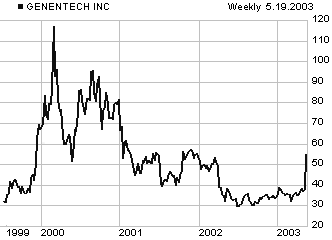 On
a May 19:
On
a May 19: 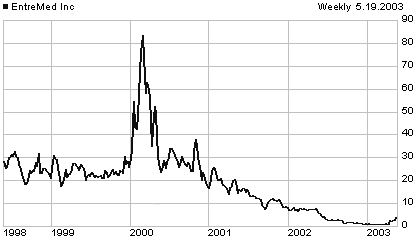 2003 Without any recent news, or analyst upgrades of their
own, 9.8 million of the 24.4 million shares of EntreMed (ENMD) are traded
on the NASDAQ, rising a similar percentage as those of Genentech, apparently
in sympathy, from a previous close of $2.61 to an intraday high of $3.78
and closing at $3.74. On 22 April 2003, EntreMed had published preclinical
findings that their drug Panzem(R)'s anti-tumor and anti-angiogenesis activity
is dependent on the drug candidate's ability to successfully inhibit both
microtubules and HIF (hypoxia inducible factor 1). These data established
Panzem(R) [2-methoxyestradiol (2ME2)], EntreMed's lead clinical drug candidate,
as a new, small molecule inhibitor of HIF, a factor that is over-expressed
in more than 70% of human cancers and their metastases, including breast,
prostate, brain, lung, and head and neck cancers. Besides cancer, HIF is
also associated with diseases of the bone and diseases that are mediated
by inflammation such as rheumatoid arthritis. Following this, ENMD shares
spiked from an intraday low of $1.08 on 22 April 2003 (8.6 million shares
traded) to an intraday high of $4.19 on 23 April 2003 (13 million shares
traded), before falling back to an intraday low of $2.14 on 30 April 2003.
Prior to that they had made their all-time high ($98.50) on the same day
as Genentech's: 28 February 2000. — [5~year price chart >]
2003 Without any recent news, or analyst upgrades of their
own, 9.8 million of the 24.4 million shares of EntreMed (ENMD) are traded
on the NASDAQ, rising a similar percentage as those of Genentech, apparently
in sympathy, from a previous close of $2.61 to an intraday high of $3.78
and closing at $3.74. On 22 April 2003, EntreMed had published preclinical
findings that their drug Panzem(R)'s anti-tumor and anti-angiogenesis activity
is dependent on the drug candidate's ability to successfully inhibit both
microtubules and HIF (hypoxia inducible factor 1). These data established
Panzem(R) [2-methoxyestradiol (2ME2)], EntreMed's lead clinical drug candidate,
as a new, small molecule inhibitor of HIF, a factor that is over-expressed
in more than 70% of human cancers and their metastases, including breast,
prostate, brain, lung, and head and neck cancers. Besides cancer, HIF is
also associated with diseases of the bone and diseases that are mediated
by inflammation such as rheumatoid arthritis. Following this, ENMD shares
spiked from an intraday low of $1.08 on 22 April 2003 (8.6 million shares
traded) to an intraday high of $4.19 on 23 April 2003 (13 million shares
traded), before falling back to an intraday low of $2.14 on 30 April 2003.
Prior to that they had made their all-time high ($98.50) on the same day
as Genentech's: 28 February 2000. — [5~year price chart >]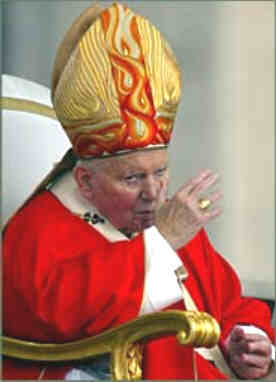 2002
Pope John Paul II [< photo], the day after his 82nd birthday,
visibly handicapped by Parkinson's disease, performs a two-and-a-half hour
canonization of five saints, including the first Brazilian one: Italian-born
Mother Paulina, who moved to Brazil in the 19th century and died in 1942
after founding an order of nuns to help orphans, children of former slaves
and the elderly in the São Paulo area.
2002
Pope John Paul II [< photo], the day after his 82nd birthday,
visibly handicapped by Parkinson's disease, performs a two-and-a-half hour
canonization of five saints, including the first Brazilian one: Italian-born
Mother Paulina, who moved to Brazil in the 19th century and died in 1942
after founding an order of nuns to help orphans, children of former slaves
and the elderly in the São Paulo area.  1897
1897
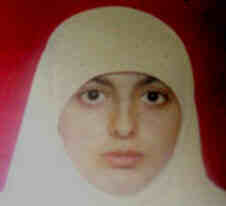 Deaths
Deaths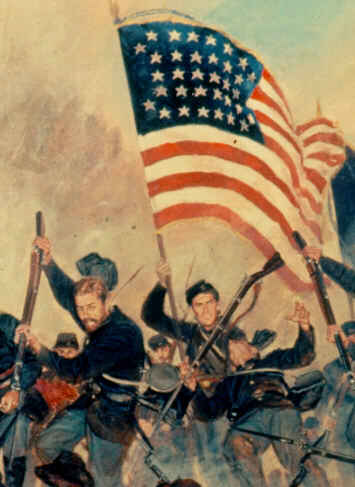
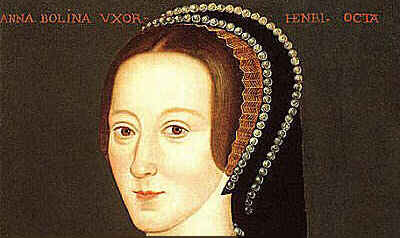 1536
1536
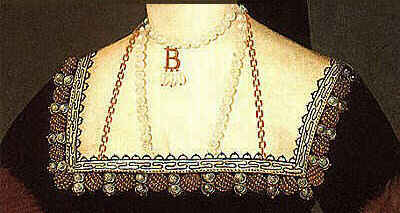 -- Henry VIII would have been beheaded if Parliament
had been even-handed and declared it treason for an unchaste king
to be married. Among
-- Henry VIII would have been beheaded if Parliament
had been even-handed and declared it treason for an unchaste king
to be married. Among 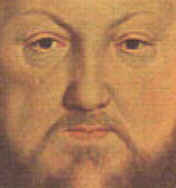
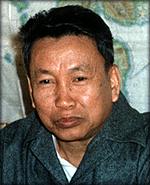 1928
1928